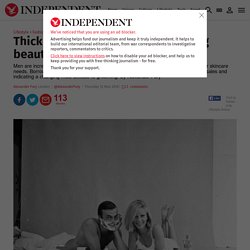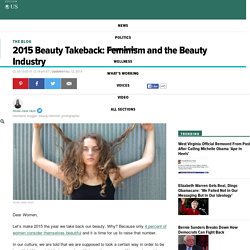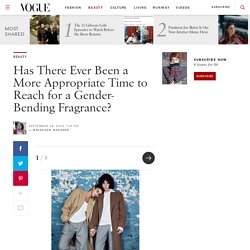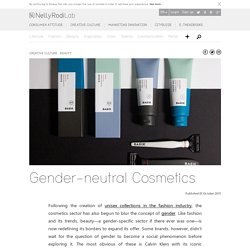

Thick Skinned: the gender-blending beauty products of now. Does skin have gender?

It’s something much of the beauty industry has spent several years (and countless millions) trying to convince us of. It’s responsible for the soaring popularity in men’s grooming, on top of a female-specific market worth over £1 billion in the UK alone. Male-orientated products make up just 5 per cent of the global skincare market, according to market research group NPD, based on retailers including John Lewis, Boots, Harrods, Harvey Nichols, Debenhams and The Perfume Shop and covering beauty brands including Clinique, Crème De La Mer, Estée Lauder, Chanel and Clarins. “What’s really interesting is the opportunity within the men’s market of premium beauty,” said June Jensen, Executive Director of NPD, back in 2013, citing that percentile difference as “big potential to boost the number of products for men.” 2015 Beauty Takeback: Feminism and the Beauty Industry Let’s make 2015 the year we take back our beauty.

Why? Because only 4 percent of women consider themselves beautiful and it is time for us to raise that number. In our culture, we are told that we are supposed to look a certain way in order to be beautiful. We are told that we are beautiful exactly as we are. We are shamed for caring about how we look, and shamed for not caring enough. Beauty is officially a feminist issue. The Women’s Liberation Movement did it’s best to call to question the double standards and injustices imposed on women — and the people who perpetrate them. The time has come for us to take our beauty power back. We need to be informed so that we can make informed choices. If I’m unsure about a product I’ll check its Skin Deep rating provided by the Environmental Working Group. I always check the ingredient list for every makeup, skincare or haircare product I purchase.
The lack of regulation within the cosmetics industry is truly despicable. Let this fact sink in. Young women 'highest mental health risk' as 'selfie' culture heaps pressure. 7 Unisex Fragrances: Beauty’s Foray into Gender Fluidity. See more photos of: Read Caption Vogue may earn compensation on these sales through affiliate programs.

Photographed by Patrick Demarchelier Photo: Courtesy of net-a-porter.com Photo: Courtesy of lelabofragrances.com Photo: Courtesy of odinnewyork.com Photo: Courtesy of ex-nihilo-paris.com Photo: Courtesy of tomford.com Photo: Courtesy of jomalone.com Photo: Courtesy of aesop.com On Sunday night, Jeffrey Tambor may take home the Emmy for Outstanding Lead Actor in a Comedy Series for his turn as Transparent’s Mort/Maura Pfefferman, a 60-something man in the process of transitioning into a woman. This week, at the New York collections, the concept of gender fluidity seemed to have carried over creatively into the minds of designers, with men walking down the runway in heels at Hood By Air and an army’s worth of female models emboldening the “boyishness” of buzz cuts at Givenchy and Alexander Wang.
Gender-neutral Cosmetics. Following the creation of unisex collections in the fashion industry, the cosmetics sector has also begun to blur the concept of gender.

Like fashion and its trends, beauty—a gender-specific sector if there ever was one—is now redefining its borders to expand its offer. Some brands, however, didn’t wait for the question of gender to become a social phenomenon before exploring it. The most obvious of these is Calvin Klein with its iconic fragrance ”CK One” that shook up the gender codes in the Nineties, followed by others like Kiehl’s, Byredo, Aesop (with its Marrakech and Tacit fragrances), Verso, Absolution and Malin Goetz. In early September, MAC announced a new unisex collection in collaboration with New York socialite brothers Harry and Peter Brant (sons of former model Stephanie Seymour and the publishing magnate Peter Brant).
This “gender-less” trend as applied to beauty is expressed in many ways and can take on many forms: Gender-neutral Packaging S.W. Benefits First. Should there be gender in the beauty industry? The world of beauty is a big and diverse one.

There are many lotions, potions, beauty brands, up and coming cosmetic lines and the industry is simply getting bigger and bigger. Over the past decade or so, it seems that more men have become open about using and purchasing beauty products. So much so that many beauty brands and companies have made sections featuring products solely targeted towards men. In a society that’s said to be open-minded and equal, is this a step to equality or a step back? Should men’s products be sectioned or should brands be all-inclusive and section the products based on function and design rather than demographic? (MALIN+GOETZ) is one beauty company that do not believe in stereotyping genders and basing their products on gender.
Speaking about their customer base, they then go on to say that their customers ‘are smart, savvy, sophisticated consumers that seek quality and results. The real question is whether this personal preference has to change. Guy Humphrey.